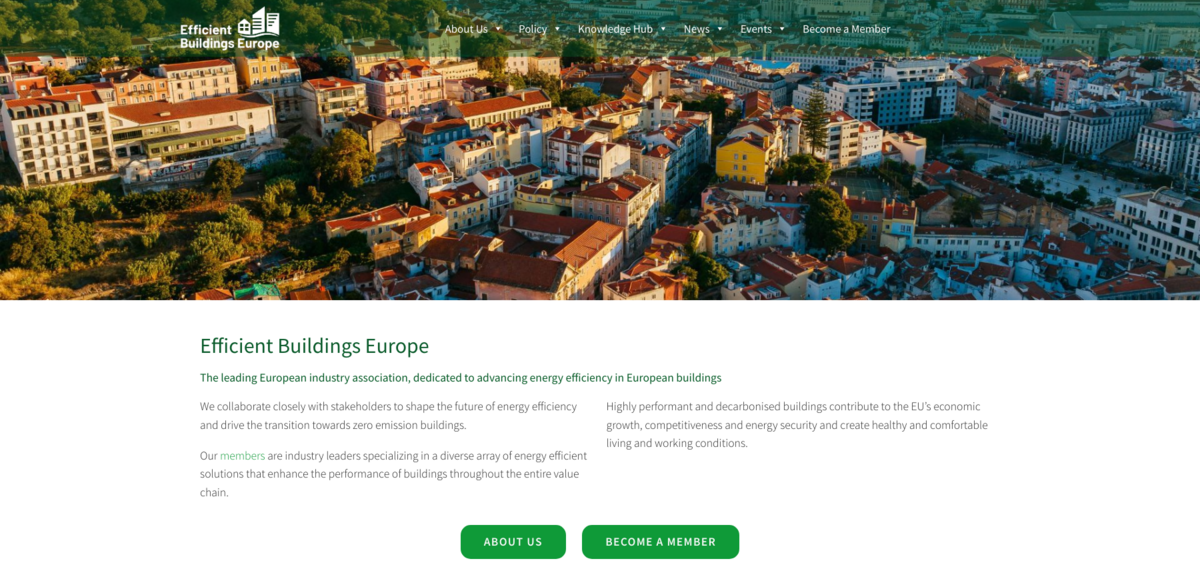What is Efficient Buildings Europe?
Efficient Buildings Europe is the leading European industry association dedicated to pushing energy efficiency forward in buildings across the continent. Born from the European Alliance of Companies for Energy Efficiency in Buildings (EuroACE) back in 1998, it was created following an invitation by the European Commission to tackle the challenge of reducing energy consumption in buildings. Fast forward to 2024, the association evolved into Efficient Buildings Europe, a name that better captures its broad scope and immediate connection to buildings. It brings together industry leaders specializing in a wide range of energy efficient solutions—from heating and cooling equipment, insulation, ventilation products, to windows, automation and control systems, design software, and water efficient products. Simply put, it’s a powerhouse of expertise working to shape the future of energy efficient buildings in Europe.
Main Benefits of Energy Efficiency in Buildings
Energy efficiency in buildings isn’t just a buzzword—it’s the number one solution for the EU to hit its energy security, economic competitiveness, and sustainability targets. Here’s why it matters:
- Buildings account for around 40% of the EU’s energy consumption and 36% of its CO² emissions.
- Energy savings in buildings are both technologically feasible and economically smart.
- Boosts the economy and creates local jobs, especially in small and medium-sized enterprises (SMEs).
- Improves health and well-being by creating comfortable living and working environments.
- Reduces energy poverty, making energy more affordable and accessible.
- Increases energy security by lowering overall demand.
- Contributes significantly to CO² emissions reduction, helping combat climate change.
The History Behind Efficient Buildings Europe
Back in 1998, EuroACE was formed by some of Europe’s leading companies delivering products, equipment, and services for energy efficient buildings. It was a cross-sectoral organisation aimed at uniting efforts to reduce energy consumption in buildings. Over the years, as the topic of energy and buildings evolved, so did the association. In 2024, it rebranded to Efficient Buildings Europe, reflecting a broader and more dynamic approach to energy efficiency. Today, it represents all energy efficient technologies under one roof, making it a unique and comprehensive voice in the sector.
Key Activities Driving Change
Efficient Buildings Europe is not just about ideas—it’s about action. The association actively works with EU institutions and other stakeholders to weave energy efficiency into all relevant EU policies. Its activities include:
- Monitoring all information related to EU energy policy for buildings.
- Developing position papers and responding to public consultations on energy efficiency matters.
- Engaging in advocacy, especially focusing on the Energy Performance of Buildings Directive (EPBD) and the Energy Efficiency Directive (EED).
- Funding substantial research on energy efficiency in buildings.
- Organising events and conferences, including National Dialogue Events.
- Managing the Renovate Europe Campaign, a key initiative to boost building renovations.
Why Renovation is Crucial
Most of today’s building stock is inefficient—and here’s the kicker—most of these buildings will still be standing in 2050. That means the opportunity (and the challenge) lies in renovating existing buildings to improve their energy performance. Increasing both the rate and depth of renovation is essential to meet the EU’s ambitious climate goals. Efficient Buildings Europe is committed to this mission, aiming for a building stock at nearly zero energy performance level by 2050. It’s about making sure buildings don’t just consume less energy but also provide healthier, more comfortable spaces for people.
Impact on Sustainable Development Goals (SDGs)
- SDG 7: Affordable and Clean Energy – promoting energy efficiency and renewable energy in buildings.
- SDG 8: Decent Work and Economic Growth – creating jobs and boosting local economies through energy efficient technologies.
- SDG 11: Sustainable Cities and Communities – enhancing the sustainability and resilience of urban environments.
- SDG 13: Climate Action – reducing CO² emissions and combating climate change.
- SDG 3: Good Health and Well-being – improving indoor environments for healthier living and working conditions.
The Road Ahead for Efficient Buildings Europe
Looking forward, Efficient Buildings Europe continues to play a pivotal role in shaping a sustainable future for Europe’s buildings. By working closely with policymakers, industry leaders, and stakeholders, it strives to ensure that energy efficiency remains at the heart of EU policies. The goal? A decarbonised, highly efficient building stock that supports economic growth, energy security, and healthier lives. The journey is ongoing, but with the right collaboration and commitment, the vision of nearly zero energy buildings across Europe by 2050 is well within reach.





















